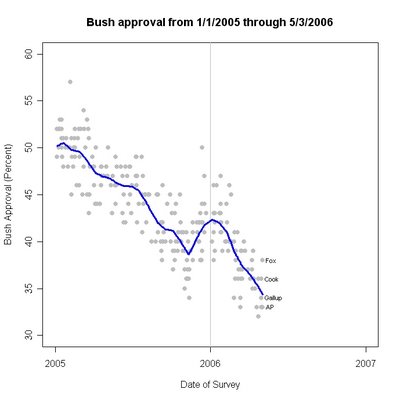
A big 5% increase in approval of President Bush in the Fox News poll is accompanied by a 3% drop in the AP poll. The Fox poll, taken 5/2-3/06, found approval at 38% and disapproval at 53%. That compares to a 33-57 rating in Fox's 4/18-19 survey. When the 33% Fox result came out, I commented here that I thought it looked a bit low compared to my then current trend estimate of 35.4% and Fox's normal +.72 house effect. Now the new one looks a bit high. My current estimate is 34.3%, even INCLUDING Fox (and the recent Cook poll at 36%). So Fox at 38% looks beyond the usual margin of error by about a percentage point. Fox, in their story accompanying the poll, noted that this survey was more heavily Republican than usual (like most pollsters, they do NOT weight by party id, so it will naturally fluctuate from sample to sample.) That difference could have pushed the result slightly higher, though not by as much as is commonly assumed (see here.) So the rebound from 33% was to be expected. The 38% seems too high now, so I'll bet on another decline to about 34% in the next Fox poll (which should appear in a couple of weeks.) These movements of Fox are a good example of how polls mix "real change" with "random fluctuation due to sampling. Sometimes it is hard to distinguish one from the other, especially in a single survey organization over only two polls. My blue trend line estimates the signal while averaging over the noise in order to provide a better estimate of approval.
The AP, meanwhile, declined to 33% approval and 65% disapproval, down from 36-62% on 4/3-5. That too is a lot of movement, but the 4/3-5 poll was close to the trend, then 36.5 and the new poll at 33% is also close to the current trend of 34.3%. Because neither is very far from expectations, I don't have any reason to predict that AP will do other than follow the overall trend in the next month.
This discussion points out how much we should expect polls to fluctuate around my trend estimate due to random sampling, measurement error, and the effects of small but ideosyncratic events (as opposed to major events that lead to durable change.) Looking back over the past 16 months, since January 2005, half of all polls have come within +/- 1.5% of my trend estimate. 80% of all polls have been within +/- 3%, and 90% have been within +/- 3.7%.
Note that that track record reveals more variation than sampling error alone would predict. Most of these polls have a sampling margin of error of about +/- 3%. In that case, we should expect 95% of polls to be within +/-3% of my trend, when in fact we only find 80% within that range. This discrepancy is due to non-sampling fluctuation, due to house effects, question wording, low response rates that induce additional randomness, and perhaps even the weighting of results back to population averages when the people so weighted may not be fully representative of the group. As response rates have declined, weighting may be inducing more randomness from poll to poll even as it "fixes" possible bias due to under-representation of some groups in the sample. For whatever reason, these data show that the polls are not by any means "terrible", but that the sampling based margin of error over-states their precision by a significant amount.
As for the President's approval ratings, despite the upturn in the Fox poll, the balance of results continue to be disappointing. The Cook poll at 36% was 2nd highest of these, but Cook was continuing a downward trend from January. No other recent poll besides Fox has found a poll-to-poll increase. As the trend line in the graph makes clear, so far the downward trend remains unabated. And the scariest thing for Republicans is the report in the AP poll that conservatives have reduced their support. If Republican support shrinks from it's unusally high levels (given overall approval, see here), then there is room for considerably more decline still.
I have yet to see a full week of good news for the White House--- something stressing competence and leadership success. Mr. Goss' resignation and a controversial nomination of General Michael V. Hayden to replace him at CIA looks to provoke disagreement between the White House and Congressional Republican leaders that can only further the damage. If Goss' resignation is a prelude to a new scandal, then the news outlook is even worse.
Watch the numbers on Republican and Independent support. If these move down it will be time to start looking for the first sub-30% approval ratings. So far President Bush has maintained Republican support above 75%, and usually above 80% (These are Gallup numbers, other polls have found more variation in Republican support). After a brief dip last month to the mid-70s, Republicans rose to 81% approval in the April 30 Gallup poll. Independents, meanwhile, have fluctuated in the mid-20s, after climbing to the mid-30s in January.
Some writers say that approval can't decline because Bush's "base" will remain solid. I think that is not the case. You can continue to be a strong conservative yet reach the conclusion that this administration simply has proven unable to accomplish its (and your) goals. The AP finding of low conservative support illustrates this. It is for that reason that support can decline yet not substantially improve Democratic prospects in November. Major losses among Republican supporters might translate into lower turnout but not into more Democratic votes. Further damage due to low approval will come from Republican candidates and incumbents abandoning the President, not due to Republican voters shifting party preferences.
Click here to go to Table of Contents